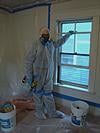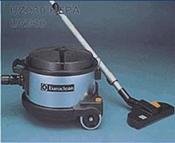|
|
Welcome to RRPedia
Your Interactive Resource for EPA RRP Information
 Looking for accurate information about the EPA RRP rule?
Looking for accurate information about the EPA RRP rule?
RRPedia has been created by Shawn McCadden to help remodelers and others affected by the New EPA Renovation Repair and Painting Rule.
Please read RRPedia Use and Contribution Information before using or contributing to RRPedia.
You Can Browse For RRP Topics By Using The Tags List To The Right
OSHA standards for cleaning a respirator apply to EPA RRP work
Posted by Shawn McCadden on Tue, Jun 01, 2010 @ 01:23 PM
Topics: OSHA Considerations, Personal Protection, Tools and Supplies
How to Safely Use a HEPA Vacuum and Change a Contaminated Bag
Posted by Shawn McCadden on Thu, Apr 29, 2010 @ 01:09 PM
The EPA RRP Model Certified Lead Renovator Courses do not address one of the critical tasks for an renovation project: How to use and maintain the HEPA vacuum. But if a renovator gets this wrong, then HEPA may not help cleanup dust. Worse, it could spread dust and cause contamination and poisoning.
Some suggestions:
-
Cleaning: If the filter - whether the HEPA filter or the prefilters - gets loaded down with dust and debris, the HEPA vacuum will not move enough air to properly and efficiently collect lead dust and lead debris from the renovation. The renovator must periodically clean the vacuum and replace the prefilter - and depending on the design - the HEPA filter.
-
Sealing: Before you turn off a HEPA vacuum, you need to cover the end of the air intake home with tape or bag the beater bar. If you don't do this, the dust and debris in the hose will fall out and recontaminate the workplace or be released in the truck or someone else's home. When you need to use the vacuum, turn the vacuum on and then remove the tape or bag. Remember, when the unit is turned off, the air intake openings must be sealed.
-
Training: When training workers consider the following:
-
-
Consider adding a demonstration about HEPA vacuum cleaning to the training. Allow traineees to open up a HEPA vacuum and see how it works.
-
Consider having the trainees practice with a new unused HEPA vacuum so you can observe and help them. Make sure it has not been used and contaminated with lead.
-
Watch the trainees during hands-on exercises to make sure they seal up the vacuum when it is turned off. If they forget, dump the debris and dust on the cleaned up workplace for a great visual and have them reclean.
-
The Wisconsin Department of Health Services developed this great two-page fact sheet on "How to Safely Change a Lead Contaminated HEPA Vacuum Bag." They use a common canister vacuum to show how to change the prefilter.
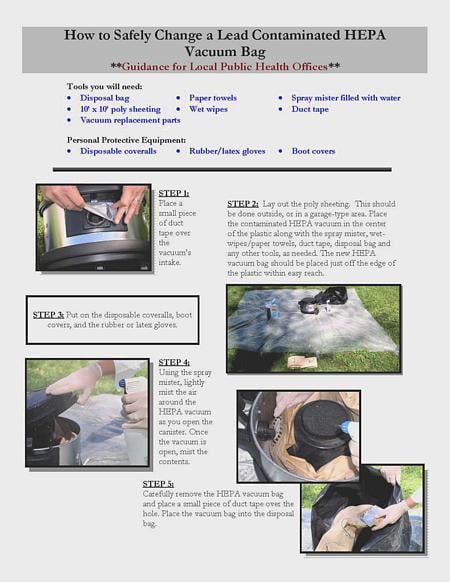
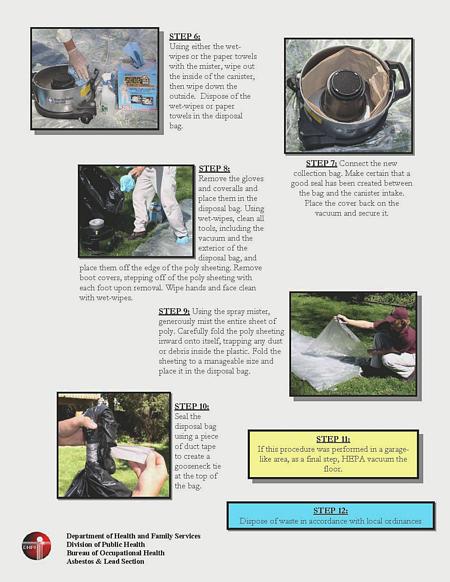
Use the following link to view and/or download the fact sheet to your computer: How to Safely Change a Lead Contaminated HEPA Vacuum Bag
Topics: HEPA Vac Info, Worker Training, Production Considerations, Work Practices, Personal Protection, Tools and Supplies
Restricted Practices and Prohibited Practices under the EPA RRP Rule
Posted by Shawn McCadden on Mon, Apr 26, 2010 @ 05:15 PM
Prohibited and Restricted EPA RRP Work Practices:
The following information comes from the RRP Rule and preamble:
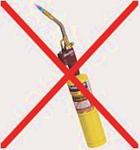
"The final rule prohibits or restricts the use of certain work practices during regulated renovations. These practices are open flame burning or torching of lead-based paint; the use of machines that remove lead-based paint through high speed operation such as sanding, grinding, power planing, needle gun, abrasive blasting, or sandblasting, unless such machines are used with HEPA exhaust control; and operating a heat gun above 1100 degrees Fahrenheit.
EPA has concluded that these practices must be prohibited restricted during renovation, repair, and painting activities that disturb lead-based paint because the work practices in this final rule are not effective at containing the spread of leaded dust when these practices are used, or at cleaning up lead-based paint hazards created by these practices. Thus, the work practices are not effective at minimizing exposure to lead-based paint hazards created during renovation activities when these activities are used."
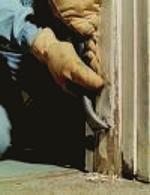 Note: The final rule does not prohibit or restrict the use of dry hand sanding or dry hand scraping. EPA has concluded that it is not necessary to prohibit or restrict dry hand sanding or dry hand scraping because the containment, cleaning, and cleaning verification requirements of the rule are effective at minimizing exposure to lead-based paint hazards created by renovations and the migration of dust-lead hazards beyond the work area when dry hand sanding or dry hand scraping is employed.
Note: The final rule does not prohibit or restrict the use of dry hand sanding or dry hand scraping. EPA has concluded that it is not necessary to prohibit or restrict dry hand sanding or dry hand scraping because the containment, cleaning, and cleaning verification requirements of the rule are effective at minimizing exposure to lead-based paint hazards created by renovations and the migration of dust-lead hazards beyond the work area when dry hand sanding or dry hand scraping is employed.
The following information is from the HUD Booklet titled Lead Paint Safety, A Field Guide for Painting, Home Maintenance and Renovation Work.

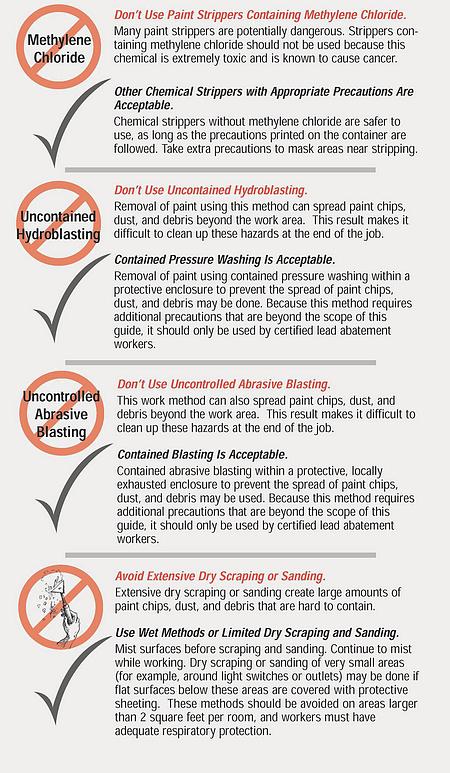
Topics: Production Considerations, Estimating Considerations, Definitions, Work Practices, Tools and Supplies
How much will it cost contractors to comply with the EPA RRP Rule?
Posted by Shawn McCadden on Tue, Apr 20, 2010 @ 10:06 AM
How much will it cost contractors to comply with the Renovation, Repair, and Painting (EPA RRP) Rule?
 First, there are up-front costs including firm certification (required to offer, sell and or be under contract to perform the work) and the cost of Certified Renovator training for those doing and or supervising the actual work. Other up front costs can include tools and equipment needed to perform the work including a HEPA vacuum, cleaning equipment, personal protection equipment for workers, specialized tools and containment related equipment such as products like Zip Walls.
First, there are up-front costs including firm certification (required to offer, sell and or be under contract to perform the work) and the cost of Certified Renovator training for those doing and or supervising the actual work. Other up front costs can include tools and equipment needed to perform the work including a HEPA vacuum, cleaning equipment, personal protection equipment for workers, specialized tools and containment related equipment such as products like Zip Walls.
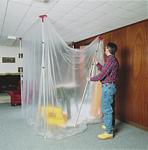
There will also be job related costs specific to the kind of work performed. Examples could include additional labor, tape, plastic sheeting, cleaning solutions, sprayers, staples, disposable wipes, HEPA filters, trash bags, tack pads, etc. Click here to request a tools and supplies shopping list. Contractors will need to consider new estimating categories/divisions as well as matching job costing categories to help verify and or improved estimated cost assumptions. Time cards and labor tracking codes should also be considered.
Contractors should also be aware of related overhead costs. These costs could include employee time to fill out and maintain required documentation, training of non-certified workers, delivery and documentation of pre-education materials, marketing and sales related expenses, time trying to get answers from the EPA, recertification costs, employee health testing, updating contracts, legal advice, insurance costs, continuing education, law suits, etc.
Contractors should devise ways to separate out EPA RRP related job costs and overhead expenses within their financial system in a way that gives them the ability to determine how RRP related compliance affects their costs of doing business.
Here is how the EPA answers this question:
"Information collected by EPA for the purposes of the rulemaking indicates that many contractors already follow some of the work practices required by the rule, such as using disposable plastic sheeting to cover floors and objects in the work area. These estimates do not include the costs of those practices.
EPA estimates that the costs of containment, cleaning, and cleaning verification will range from $8 to $167 per job, with the exception of those exterior jobs where vertical containment would be required. This includes:
· Costs of equipment (for example, plastic sheeting, tape, HEPA vacuums and tool shrouds - the equipment varies by job).
· Costs of labor (for example, the time required to perform cleaning and cleaning verification).
In addition to work practice costs, your costs will include training fees and certification fees. The costs include:
· Training costs to individual renovators working in pre-1978 housing or child-occupied facilities who must take a course from an accredited training provider (cost is set by the training provider; estimated to be about $200 for a 5-year certification).
· Certification costs to firms to obtain certification from EPA ($300 fee to the U.S. Treasury for a 5-year certification. (This fee is required by law to cover program administration)."
Topics: Business Financials, RRP Questions, Legal Considerations, Estimating Considerations, Business Considerations, Tools and Supplies
EPA RRP definition of a HEPA VAC and how to choose one
Posted by Shawn McCadden on Mon, Apr 19, 2010 @ 02:01 PM
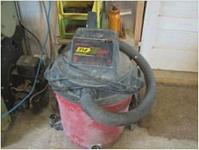 The EPA has established a specific definition for a HEPA Vacuum under the EPA RRP Rule. A Shop vac equipped with a HEPA filter will not satisfy the requirements of the RRP Rule. Using the wrong vacuum for RRP work could subject you to a $37,500 fine per violation per day of use of the wrong vacuum.
The EPA has established a specific definition for a HEPA Vacuum under the EPA RRP Rule. A Shop vac equipped with a HEPA filter will not satisfy the requirements of the RRP Rule. Using the wrong vacuum for RRP work could subject you to a $37,500 fine per violation per day of use of the wrong vacuum.
Here is the EPA definition of a HEPA vacuum taken from the rule itself:
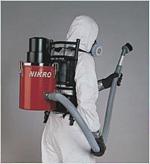 "Final rule requirements. Vacuums used as part of the work practices being finalized in this final rule must be HEPA vacuums which are to be used and emptied in a manner that minimizes the reentry of lead into the workplace. The term "HEPA vacuum'' is defined as a vacuum which has been designed with a HEPA filter as the last filtration stage. A HEPA filter is a filter that is capable of capturing particles of 0.3 microns with 99.97% efficiency. The vacuum cleaner must be designed so that all the air drawn into the machine is expelled through the filter with none of the air leaking past it."
"Final rule requirements. Vacuums used as part of the work practices being finalized in this final rule must be HEPA vacuums which are to be used and emptied in a manner that minimizes the reentry of lead into the workplace. The term "HEPA vacuum'' is defined as a vacuum which has been designed with a HEPA filter as the last filtration stage. A HEPA filter is a filter that is capable of capturing particles of 0.3 microns with 99.97% efficiency. The vacuum cleaner must be designed so that all the air drawn into the machine is expelled through the filter with none of the air leaking past it."
The rule also further specifies the use of a beater bar when vacuuming carpets or rugs during final cleaning.
"After the sheeting has been removed from the work area, the entire area must be cleaned, including the adjacent surfaces that are within 2 feet of the work area. The walls, starting from the ceiling and working down to the floor, must be vacuumed with a HEPA vacuum or wiped with a damp cloth. This final rule requires that all remaining surfaces and objects in the work area, including floors, furniture and fixtures, be thoroughly vacuumed with a HEPA-equipped vacuum. When cleaning carpets, the HEPA vacuum must be equipped with a beater bar to aid in dislodging and collecting deep dust and lead from carpets. Where feasible, floor surfaces underneath area rugs must also be thoroughly vacuumed with a HEPA vacuum."
Renovators should think about the kind of work they do and related cleanup requirements before purchasing a HEPA vac. It might even be wise to have more than one depending on the purpose it would be used for. For example, a small HEPA vac might be easy to carry and adequate for small and or quick cleanups. But, dragging a small vac with wheels around a large work area might be cumbersome and dragging it around through dust and debris might contaminate the vac. On the other hand, a back pack style HEPA vac would be great for vacuuming the walls and or floors of a large work area.
Click here for an article about HEPA Vacuums, things to consider before purchasing one and some helpful links to manufacturers offering HEPA vacuums.
EPA Waffles on Which Vacuums Can Be Used to Clean Up Lead: This JLC article by Ted Cushman discusses challenges manufacturers are having verifying compliance of their HEPA vacs with the EPA requirements. In addition to the high price tag that comes with a HEPA vac, these same challenges are also making it difficult for renovators trying to choose which vac to purchase.
Topics: HEPA Vac Info, Definitions, Tools and Supplies
What do I need to know about Respirators when doing EPA RRP work?
Posted by Shawn McCadden on Sat, Apr 17, 2010 @ 01:01 PM
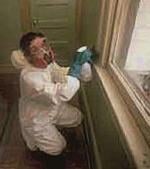 Many Certified Renovators, after taking the required EPA RRP certification class, leave with questions about respirators. The RRP rules are not specific about the need or requirement for workers to use respirators while performing work practices, but there are OSHA rules to consider. For information regarding OSHA requirements contractors can refer to the OSHA document titled Small Entity Compliance Guide for the Revised Respiratory Protection Standard
Many Certified Renovators, after taking the required EPA RRP certification class, leave with questions about respirators. The RRP rules are not specific about the need or requirement for workers to use respirators while performing work practices, but there are OSHA rules to consider. For information regarding OSHA requirements contractors can refer to the OSHA document titled Small Entity Compliance Guide for the Revised Respiratory Protection Standard
There is also more information about respiratory protection at the OSHA web Site. If you want a quick resource of OSHA information about respirators try the Respiratory Protection Frequently Asked Questions page of the OSHA web site.
If you are a certified renovator tying to figure out where to get started about respirators, the following information is from the HUD Booklet titled Lead Paint Safety, A Field Guide for Painting, Home Maintenance and Renovation Work. It should give you a good idea of when respirators would be required or not. It can also help identify when you should consider OSHA Requirements on RRP related work. The booklet also includes very thorough instructions, for working lead safe, specific to performing a variety of projects. It could be a great resource for contractors trying to collect effective and innovative lead safe work practices, just be sure to stay in compliance with RRP rules.
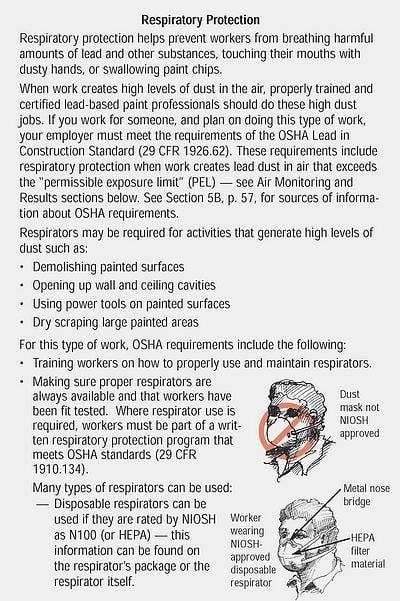
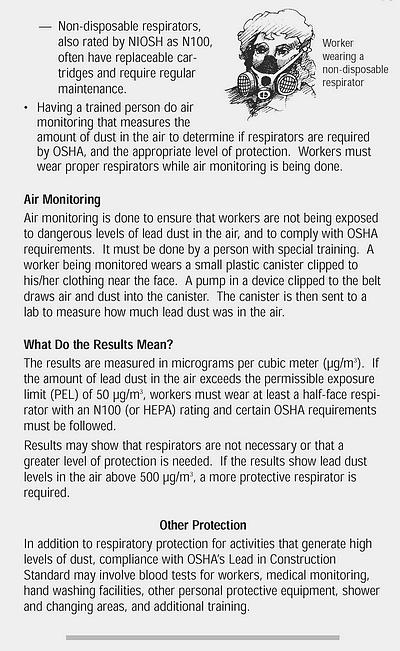
Topics: Worker Training, OSHA Considerations, Work Practices, Personal Protection, Tools and Supplies

